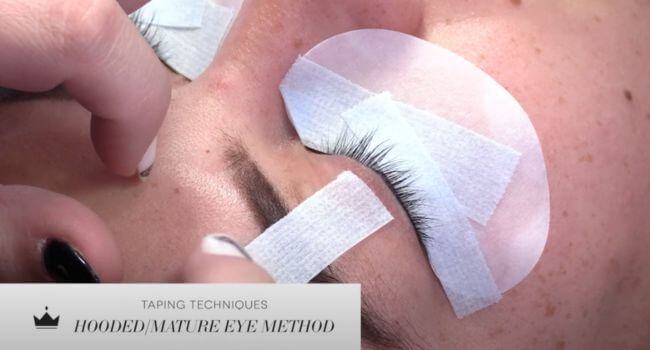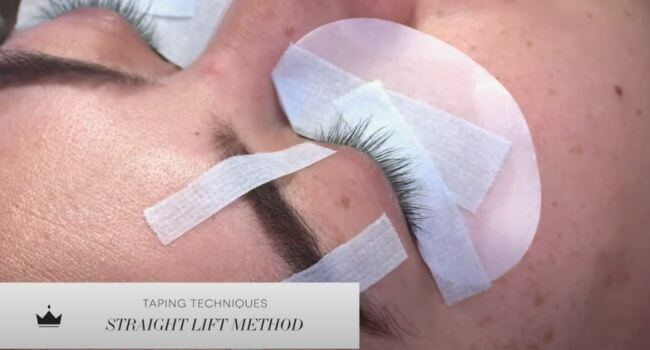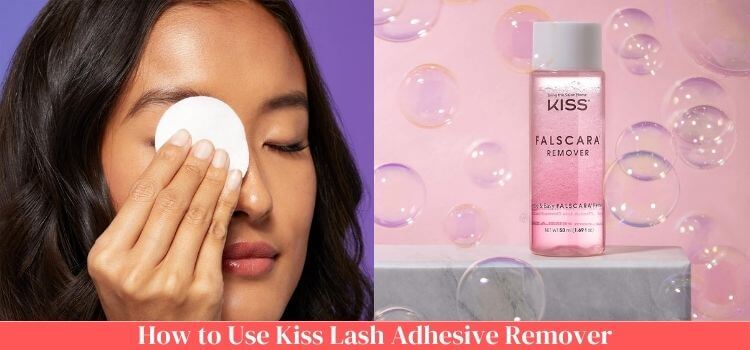As an Amazon Associate, I earn from qualifying purchases.

Eyelash extensions have become popular, allowing individuals to enhance their natural lashes for a more voluminous and glamorous look. Attaining the perfect set of eyelash extensions requires precise and detailed taping of the lashes.
Understanding Eyelash Taping
Before diving into the step-by-step guide, it’s crucial to understand the basics of eyelash taping. There are different types of tapes available, each with its unique properties. Choosing the suitable tape is essential for ensuring a comfortable and effective extension application process.
To start, prepare the eye area by cleansing and priming the natural lashes. This sets the foundation for a seamless taping experience.
How to Tape Eyes for Eyelash Extensions
Materials Needed
Before delving into the intricacies of taping, gather the necessary materials for a flawless application:
High-quality Tape
Invest in a reliable, hypoallergenic tape explicitly designed for eyelash extensions. The suitable tape will adhere well without irritating.
Scissors
Precision is vital, so ensure you have sharp scissors to cut the tape accurately and efficiently.
Lash Pads
Lash pads provide a comfortable surface for clients to rest their eyes during the application. They also aid in securing the lower lashes, preventing interference with the upper lashes.
Cleaning Solution
A gentle cleaning solution is essential for preparing the lashes before taping. This ensures the removal of any residual oils or makeup that may affect the tape’s adhesion.
Step-by-Step Guide on Taping Lashes
Step 1: Cleanse and Prime Natural Lashes
Begin by cleansing the natural lashes to remove any makeup residue or oils. Follow up with a primer to ensure a clean and adhesive-friendly surface.

Step 2: Measure and Cut Tape Strips
Accurately measure and cut tape strips, considering the individual’s eye shape. This step is crucial for achieving precise isolation of lashes during the extension application.

Step 3: Properly Apply Tape to Isolate Lashes
Gently apply the tape strips to isolate the lashes. Ensure that the tape adheres securely without causing discomfort to the client.

Step 4: Securing Lower Lashes with Additional Tape
For added protection, use additional tape to secure lower lashes, preventing any interference during the extension application process. 4 ways to Tape Down Bottom Lashes
Method 1: Inner Corner Reveal Method

Method 2: Hooded/ Mature Eye Method

Method 3: Straight Lift Method

Method 4: Cross lift Method

Common Mistakes and How to Avoid Them
While taping is a straightforward process, inevitable mistakes can compromise the results. Be aware of the following common pitfalls:
Tape Overlapping Issues
Overlapping tape can lead to uneven application and discomfort for the client. Ensure each strip is applied with precision, avoiding unnecessary layers.
Allergic Reactions to Tape
Always inquire about allergies before taping. Use hypoallergenic tape to minimize the risk of adverse reactions.
Inadequate Tape Adhesion
Improper adhesion can result in the tape coming loose during the application. Press the tape firmly, especially at the corners, to ensure it stays in place.
Benefits of Proper Taping
Understanding the benefits of proper taping reinforces its significance in the eyelash extension process:
Enhanced Extension Longevity
Well-taped lashes contribute to a secure bond between the natural and synthetic lashes, prolonging the life of the extensions.
Reduced Irritation and Discomfort
An application that is comfortable for the customer is ensured by properly taped lashes, which reduces the chance of discomfort.
Improved Overall Lash Appearance
Taping sets the foundation for a flawless extension application, enhancing the overall appearance of the lashes and creating a stunning, natural look.
Tips for a Seamless Extension Application
Please make sure the tape placement is comfortable for the client and use it as a guide for extension placement. This ensures a seamless application process and a satisfied client.
Maintaining Lash Health Post-Application
Post-application care is vital. Removing tape carefully and recommending a suitable aftercare routine contributes to the long-term health of both natural and extended lashes.
Addressing Common Concerns
Clients often have concerns about potential irritation, allergies, and the impact on natural lash growth. Addressing these concerns transparently helps build trust and confidence.
Expert Insights and Recommendations
Gain insights from experienced lash technicians and explore recommended products for taping. Learning from the experts in the field can elevate your taping technique.
Visual Guide: Infographics on Proper Taping Techniques
Visual aids, such as infographics, clearly and concisely represent each taping step and highlight common mistakes to avoid.
Real-Life Client Experiences
Positive feedback from clients who have experienced proper taping reinforces the importance of this technique. Addressing and resolving any client issues contributes to a positive overall experience.
Industry Trends in Eyelash Extension Application
Stay updated on industry trends, including taping techniques and tape technology advancements. Adapting to these trends can set you apart as a knowledgeable and skilled lash technician.
Frequently Asked Questions (FAQs)
- How long should the tape be applied before extensions?
- Ensure the tape is applied just before starting the extension process for optimal results.
- Can I use regular tape for eyelash extensions?
- It’s recommended to use specialized tape designed for eyelash extension applications.
- Is taping uncomfortable for clients?
- When done correctly, taping should not cause discomfort. Discuss any issues with the client through communication.
- Are there alternatives to tape for lash isolation?
- While tape is commonly used, some technicians prefer gel pads or other isolation tools.
- How often should tape be changed during application?
- Change tape as needed to maintain a secure and comfortable application environment.
Conclusion
In conclusion, mastering the art of taping lashes for extensions is a crucial skill for any lash technician. By understanding the process, avoiding common mistakes, and incorporating expert recommendations, you can ensure your clients a successful and comfortable experience.






